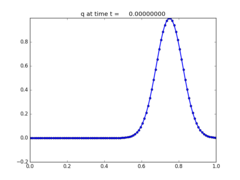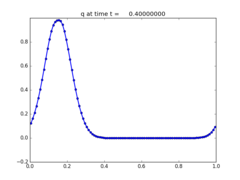1-dimensional advection¶
One-dimensional advection¶
Solve the linear advection equation:
\[q_t + u q_x & = 0.\]
Here q is the density of some conserved quantity and u is the velocity.
The initial condition is a Gaussian and the boundary conditions are periodic. The final solution is identical to the initial data because the wave has crossed the domain exactly once.
Source:¶
#!/usr/bin/env python
# encoding: utf-8
r"""
One-dimensional advection
=========================
Solve the linear advection equation:
.. math::
q_t + u q_x & = 0.
Here q is the density of some conserved quantity and u is the velocity.
The initial condition is a Gaussian and the boundary conditions are periodic.
The final solution is identical to the initial data because the wave has
crossed the domain exactly once.
"""
from __future__ import absolute_import
import numpy as np
from clawpack import riemann
def setup(nx=100, kernel_language='Python', use_petsc=False, solver_type='classic', weno_order=5,
time_integrator='SSP104', outdir='./_output'):
if use_petsc:
import clawpack.petclaw as pyclaw
else:
from clawpack import pyclaw
if kernel_language == 'Fortran':
riemann_solver = riemann.advection_1D
elif kernel_language == 'Python':
riemann_solver = riemann.advection_1D_py.advection_1D
if solver_type=='classic':
solver = pyclaw.ClawSolver1D(riemann_solver)
elif solver_type=='sharpclaw':
solver = pyclaw.SharpClawSolver1D(riemann_solver)
solver.weno_order = weno_order
solver.time_integrator = time_integrator
if time_integrator == 'SSPLMMk3':
solver.lmm_steps = 5
solver.check_lmm_cond = True
else: raise Exception('Unrecognized value of solver_type.')
solver.kernel_language = kernel_language
solver.bc_lower[0] = pyclaw.BC.periodic
solver.bc_upper[0] = pyclaw.BC.periodic
x = pyclaw.Dimension(0.0,1.0,nx,name='x')
domain = pyclaw.Domain(x)
state = pyclaw.State(domain,solver.num_eqn)
state.problem_data['u'] = 1. # Advection velocity
# Initial data
xc = state.grid.x.centers
beta = 100; gamma = 0; x0 = 0.75
state.q[0,:] = np.exp(-beta * (xc-x0)**2) * np.cos(gamma * (xc - x0))
claw = pyclaw.Controller()
claw.keep_copy = True
claw.solution = pyclaw.Solution(state,domain)
claw.solver = solver
if outdir is not None:
claw.outdir = outdir
else:
claw.output_format = None
claw.tfinal =1.0
claw.setplot = setplot
return claw
def setplot(plotdata):
"""
Plot solution using VisClaw.
"""
plotdata.clearfigures() # clear any old figures,axes,items data
plotfigure = plotdata.new_plotfigure(name='q', figno=1)
# Set up for axes in this figure:
plotaxes = plotfigure.new_plotaxes()
plotaxes.ylimits = [-.2,1.0]
plotaxes.title = 'q'
# Set up for item on these axes:
plotitem = plotaxes.new_plotitem(plot_type='1d_plot')
plotitem.plot_var = 0
plotitem.plotstyle = '-o'
plotitem.color = 'b'
plotitem.kwargs = {'linewidth':2,'markersize':5}
return plotdata
if __name__=="__main__":
from clawpack.pyclaw.util import run_app_from_main
output = run_app_from_main(setup,setplot)



